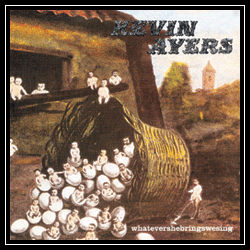|
|
 |

|
 |
Dusted Features
Dusted's John Eyles takes a look at three newly released reissues by Kevin Ayers.
|
|
|
 |
Kevin Ayers
Kevin Ayers is probably still best known as one of the founding members of Soft Machine - with Daevid Allen, Mike Ratledge and Robert Wyatt - when their music was as much psychedelic English whimsy as serious jazz-rock fusion. He left in 1968. Or maybe he is remembered as a quarter of (the short-lived and unfortunately named) ACNE, along with legends John Cale, Nico and Eno; their Rainbow concert of 1974 - immortalized on June 1st 1974 (Island) – is fondly remembered and Ayers is often credited with stealing the show.
Anyway… between Soft Machine and ACNE, Ayers released these, his first three solo albums, in 1969, 1970 and 1972 (plus a fourth, Bananamour, in 1973). None particularly stands out as a favorite; each has its merits and its champions, and there are fine songs peppered through all of them. Joy of a Toy is a transitional album, from Soft Machine to solo; “Joy of a Toy” was a track on the first Soft Machine album, and there is a continuation track here; all of the members of Soft Machine played on this album, Robert Wyatt providing all drums. Despite this, there is more than enough Ayers present for it truly to be considered a solo album. Above all, the songs are far better – more melodic and memorable - than any by Soft Machine; there are a few very forgettable songs - the sub-Dylan “All This Crazy Gift Of Time,” the inconsequential “Girl On A Swing.” And the ploddingly dull “The Clarietta Rag” is a prime example of the worst type of English whimsy, in the tradition of music hall, the English equivalent of vaudeville. Most English groups of the period produced similar aberrations – “Mr Kite,” anyone? – so let’s not dwell overlong on it.
Instead let’s focus on the good stuff: “Town Feeling,” “Song For Insane Times,” “Stop This Train (Again Doing It),” “The Lady Rachel,” “Oleh Oleh Bandu Bandong” all stand up very well. In different ways, each evokes the spirit of the times. Ayers was always reluctant to just let a song stand on its merits; there was usually some bit of trickery in there. So, the vocals on “Stop This Train” distort Ayers’ rich, full voice with a through-a-megaphone vocal effect; “Oleh Oleh Bandu Bandong” has backing vocals in Malay and some very free piano over a thumping beat, and so on. Sometimes these intrude, but just as often they come over as charming... or charmingly naïve.
By the time of Shooting at the Moon, Ayers had formed the touring band The Whole World with David Bedford (who’d arranged most of the previous album) on keyboards, a teenage Mike Oldfield on guitar, Lol Coxhill on saxes and Mick Fincher on drums. The album opens strongly; “May I” is one of Ayers’ very best, with its brooding slow melody and classic lines, addressed to an unknown woman – “May I / sit and stare at you / for a while,” would today signal harassment but at the time were highly appealing to many female Ayers fans. “Lunatics Lament” features a stunning guitar solo from Oldfield, a taste of things to come. “Reinhardt And Geraldine / Colores Para Dolores” consists of two strong melodies, separated by a freak-out collage constructed of edited instrumental snippets, reminiscent of Zappa in experimental mode. On this album, the trickery dominates the songs; there are large chunks that are highly experimental and improvised. So, “Pisser Dans Un Violon” is eight minutes of low-key free improv. It’s immediately followed by the (Lewis Carroll influenced) “The Oyster And The Flying Fish,” a jolly sing-along ditty. Then comes “Underwater,” four more minutes of bass-dominated improv, then “Clarence in Wonderland” that rhymes “moon,” “June” and “soon.” The end result is an album that can’t make up its mind what it wants to be. Maybe Ayers was short of decent songs, and improvisation was seen as easy filler. Alternatively, this may be how Soft Machine would have evolved had Ayers remained, an uneasy marriage of songs and improvisation.
On Whatevershebringswesing, although The Whole World are gone, Bedford and Oldfield remain as vital components of the sound. The blend is as before, and the album again contains some strong songs, most notably “Song From The Bottom Of A Well” and “Stranger In Blue Suede Shoes.” Both employ Ayers’ brooding baritone effectively, giving them a darker, more menacing edge than any previous songs. With its driving rhythm, cast of characters and drug allusions, “Stranger In Blue Suede Shoes” would not have been out of place on Transformer. (His pairing with Cale & Nico in ACNE was timely.) The album’s title track may be the quintessential Ayers song, leisurely paced, laid back, gently melodic, with a relaxed attitude to life (“Let’s drink some wine / and have a good time”).
Sadly, bonus tracks that were on past reissues - such as “Soon Soon Soon” or “Singing a Song in the Morning” that were added to Joy of a Toy - are absent here; these are straight reissues of the original vinyl LP’s. This can leave the CD’s a little short on playing time - Whatevershebringswesing doesn’t make it past 37 minutes, but quality always beats quantity, eh?
Ayers never made a stone classic album, but if the best songs here were put together that is what they would make. Largely because of this music, Ayers is still beloved by many who lived through those times – beloved for his music but equally for his personality and his sod-it attitude to fame. He could have been - maybe should have been – massive… but he preferred to go fishing. Great guy.
By John Eyles
|







